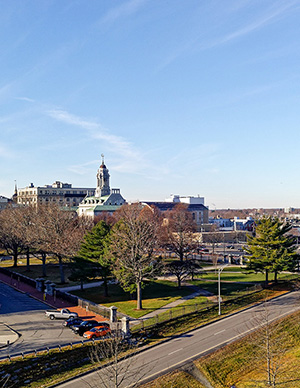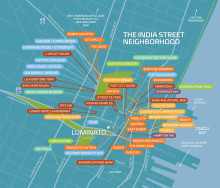Fascinating History of Portland’s India Street Neighborhood
On July 4, 1866, a raging fire destroyed a great portion of the city, including India Street between Congress and Middle, all of Hampshire Street, most of Federal and Sumner (now Newbury) Streets. The Great Fire was the largest urban fire the United States had seen to that point and it irrevocably changed the look of large portions of Portland.
In the aftermath of the Great Fire, much of the city was rebuilt in brick. Middle and Exchange Streets remained the focus of the city’s commercial activity. The India Street neighborhood was slower to rebuild than parts of downtown.
Almost all of the residential buildings constructed in the neighborhood after the fire were multi- family dwellings, reflecting Portland’s increasingly urbanized character and the neighborhood’s rapidly growing population. India Street served as a transportation hub, with large numbers of people coming and going via the railroad, the streetcars, and the steamships that docked at the foot of India. 4,000 immigrants per year entered the port of Portland throughout the 1890s. By 1910, the city directory shows large numbers of Italians and Eastern European Jews living in the India Street neighborhood, alongside the earlier Irish immigrants. The 1920 Census, on Federal Street alone, lists the following countries of origin: Scotland, England, Ireland, Finland, Estonia, Sweden, Russia, Portugal, Poland, Lithuania, and Canada.
Italian immigrants were the next wave. They began arriving in large numbers around the turn of the last century. The India Street neighborhood absorbed all these newcomers (not always graciously, alas), as well as arrivals from Canada and the Scandinavian countries. Taverns, hotels, and small businesses (junk shops, fruit shops, restaurants, pool halls, bakeries, livery stables, plumbing, dry cleaning, and shoe repair businesses, etc.) served the various, everyday needs (not all of them legal) of the many people living in or passing through the neighborhood. The neighborhood provided a home for people who were not necessarily welcome in other parts of the city (as was the case for many immigrants and minorities) or who did not wish to participate in the fixed, stable life of the middle class (the many lodgers and transients who passed through). Street hotels featured frequently in the papers because of robberies, brawls, even murder – the Florence Hotel (45 India Street, now Micucci’s) and the Liverpool Tavern (corner of India and Commercial).
Excerpted from the History of Portland’s India Street Neighborhood. Researched and written by Julie Larry and Gabrielle Daniello, TTL Architects for the City of Portland’s Historic Preservation Office.


